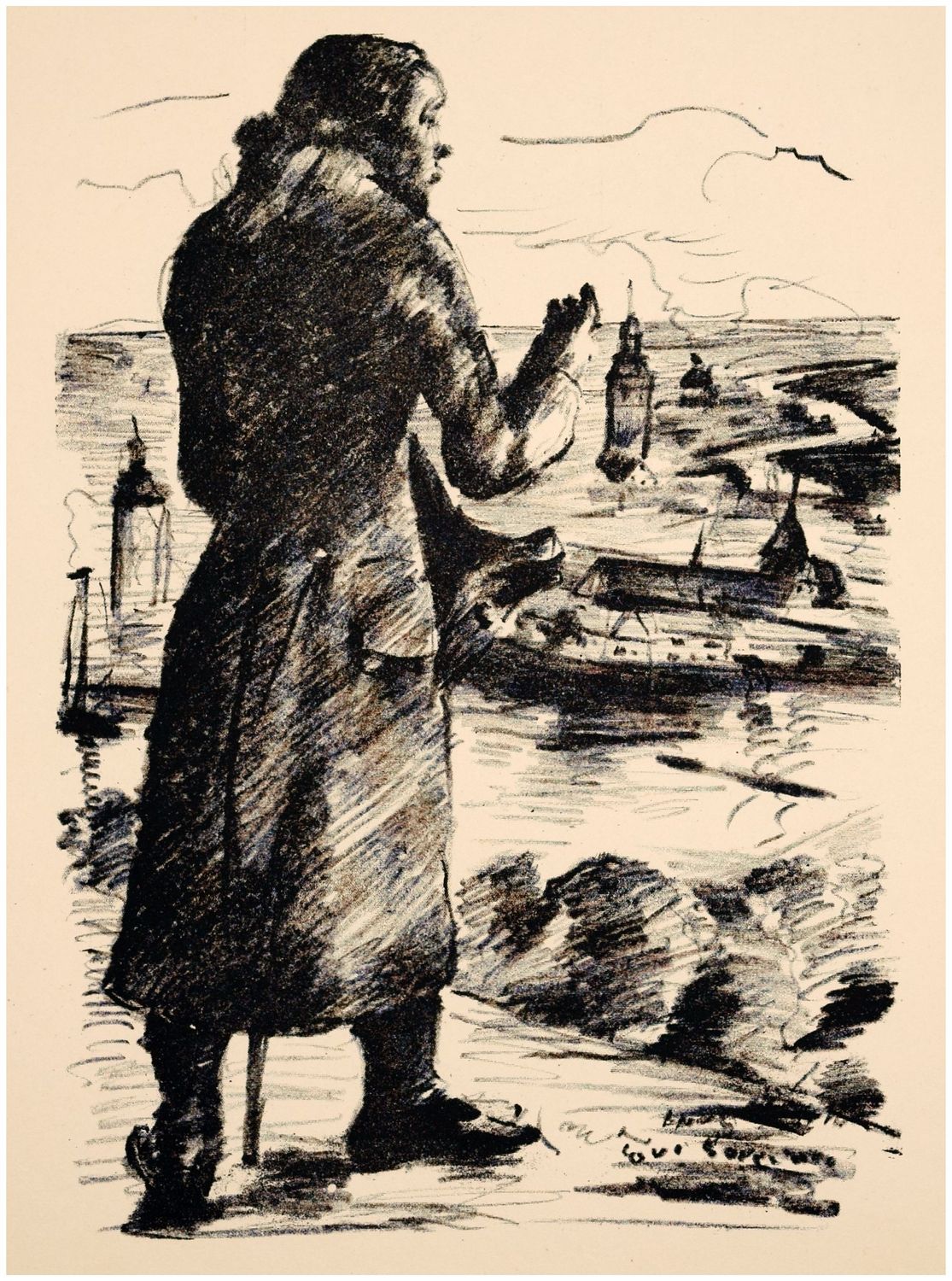Corinth, Lovis (1858-1925), “Barbarians”: Immanuel Kant, 1915
Lovis Corinth(1858 Tapiau - 1925 Zandvoort), “Barbarians”: Immanuel Kant , 1915, From: Krieg und Kunst, 5. Folge, Berlin 1915. Chalk lithograph, 28.2 cm x 20 cm (image), 41.8 cm x 33.5 cm (sheet size), identified and titled as a work by Lovis Corinth lower right, with the signet of the Berlin Secession lower left.
- slightly brownstained in the lower margin, occasional minimal creases, overall in good condition
- The Morality of War -
Lovis Corinth positions Immanuel Kant on a hill and lets the philosopher look out over the lagoon of Königsberg. With one hand he has taken off his hat, while with the other he points to the world before him. By crossing the horizon line with his hand, he refers to the world as such. The hand is parallel to the shape of the church tower, whose spire also reaches into the sky. In spite of faith and the moral principles associated with it, human beings are, for Kant, "barbarians," as the author of "Zum ewigen Frieden" (1795) is forced to observe in the face of the unfolding world conflagration.
About the artist

Determined to become an artist, Corinth entered the Königsberg Art Academy in 1876, where he studied under Otto Günther, who introduced him to Weimar plein-air painting. On Günther's recommendation, Corinth moved to the Munich Art Academy in 1880. There, under the influence of the circle of Leibl and Wilhelm Trübner, he adopted a naturalistic approach to art that was opposed to academic history painting.
After interrupting his studies for a year to do voluntary military service, Corinth went on a study trip to Italy in 1883 and the following year to Antwerp, where he took art lessons from Paul Eugène Gorge. From 1884 to 1887, Corinth stayed in Paris and devoted himself mainly to nude painting at the private Académie Julian.
After a stopover in Berlin, where he met Max Klinger, Walter Leistikow and Karl Stauffer-Bern, Corinth lived in Munich from 1891 to 1901 and became a founding member of the Munich Secession, which was founded in 1892 by Max Liebermann, Otto Eckmann, Thomas Theodor Heine, Hans Olde, Hans Thoma, Wilhelm Trübner, Franz von Stuck and Fritz von Uhde. The Secession gave rise to the Free Association of the XXIV or Munich 24, to which Corinth also belonged.
In 1894, under the tutelage of Otto Eckmann, Corinth learnt the art of etching and, in the field of painting, developed the wet-on-wet style that would characterise his work and lead to the relief-like texture of his paintings.
His relationship with Berlin became more and more intense. When he attended the first exhibition of the Berlin Secession in 1899, he painted a portrait of Liebemann, who in turn painted a portrait of Corinth. After the Munich Secession rejected his painting Salome, he finally moved to Berlin, where the painting was admired at the Secession exhibition and Corinth - through Leistikow - became a much sought-after portraitist.
In 1903 Corinth opened an art school and in 1904 he married his first pupil, Charlotte Berend. His first solo exhibition was organised by Paul Cassirer. In Berlin, Corinth also began to devote himself to the theatre. He worked with Max Reinhardt, designing sets and costumes.
Following Max Liebermann's resignation, Corinth was elected chairman of the Secession in 1911. In the same year, he suffered a stroke that paralysed half of his body. He then devoted himself intensively to graphic art and opened up the field of book illustration.
In 1913, Paul Cassirer organised the first major retrospective of Corinth's work, and in 1918, on his 60th birthday, the Berlin Secession devoted a major exhibition to his work. In 1923, on his 65th birthday, his artistic career was crowned with a extense solo exhibition at the National Gallery.
Even after the 'Freie Sezession' split from the 'Berliner Sezession', Corinth remained in the original association, becoming chairman again in 1915 and professor at the Berlin Academy of Arts the following year.
In 1919, the Corinths purchased the retreat at the Walchensee in Bavaria, which Corinth captured in more than 60 paintings. Corinth died in 1925 on a trip to Amsterdam to see his great idols, Frans Hals and Rembrandt.
Selected Bibliography
Heinrich Müller: Die späte Graphik von Lovis Corinth, Hamburg 1960.
Thomas Deecke: Die Zeichnungen von Lovis Corinth. Studien zur Stilentwicklung, Berlin 1973.
Zdenek Felix (Hrsg.): Lovis Corinth. 1858–1925, Köln 1985.
Karl Schwarz: Das Graphische Werk von / The Graphic Work of Lovis Corinth, San Francisco 1985.
Horst Uhr: Lovis Corinth, Berkeley 1990.
Charlotte Berend-Corinth: Lovis Corinth: Die Gemälde. Neu bearbeitet von Béatrice Hernad, München 1992.
Peter-Klaus Schuster / Christoph Vitali / Barbara Butts (Hrsg.): Lovis Corinth, München 1996.
Michael F. Zimmermann: Lovis Corinth, München 2008.

